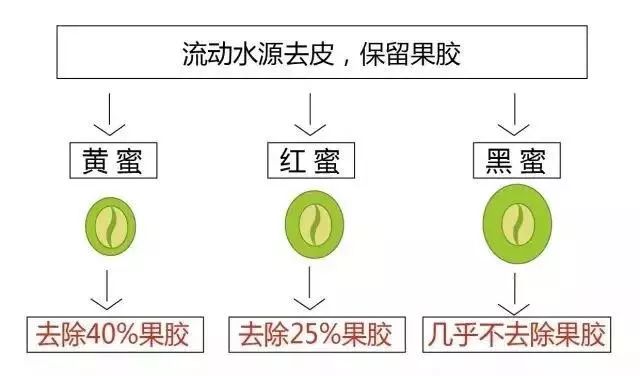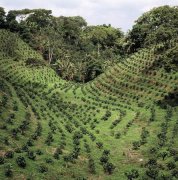Honey treatment differs from other treatments in the taste characteristics of blueberry coffee beans at Costa Rica's Stone Manor
Honey treatment
When the editor just heard about the treatment of "honey treatment", he was very curious about what kind of processing process he could have such a sweet name. After this treatment of coffee beans will show what kind of flavor characteristics, then with me to explore the mystery of "honey treatment"!
First of all, let's take a look at Qianjie Coffee's blueberry from Stonehenge Manor, Costa Rica, which has been treated with anaerobic double honey.
Qianjie Coffee Blueberry Boulder Manor
Producing area: Brenka, Costa Rica
Manor: Stonehenge Manor
Altitude: 1700-1800
Variety: Kaddura Kaduai
Treatment method: anaerobic heavy honey treatment
Baking degree: moderate
The dry aroma of this coffee has obvious candy and fermented aromas. after brewing, the entrance is the sweetness of blueberry fudge, the fermented aroma appears slowly, and the sweetness is very superior.
The anaerobic fermentation treatment of this coffee refers to putting the screened coffee beans into an airtight container, injecting carbon dioxide into the closed container and squeezing out the oxygen in the closed container, which slows down the decomposition rate of sugar in coffee pectin in an oxygen-free environment, and the PH value decreases more slowly, prolonging the fermentation time, thus developing a better sweetness and a more balanced flavor. And finally get a coffee bean with a different flavor.

What is honey treatment? Honey treatment is to keep the pectin part of coffee beans for drying on the basis of traditional washing and sunlight.

Processing steps
1. People and workers screen out high-quality ripe coffee cherries
2. Remove exocarp and pulp by machine
3. Sun-drying with pectin (different pectin residues will have different flavor)
4. Drying to moisture content of 11-13%
5. Warehousing, waiting for export
Before the coffee beans are roasted, there are several layers of matter to be removed from the outer layer of the fruit, and then the coffee beans are dried to a moisture content of about 11%. There are two common treatments: washing with water to remove the pectin layer. and the sun treatment of directly exposing the fruit and removing the outer layer.
Honey treatment is somewhere in between, the outer layer of the fruit will be partially removed, and part of the pectin layer will be retained and dried.
What is the difference between yellow honey, red honey and black honey?
We have a preliminary understanding of honey treatment, and then look at different honey-treated coffee. These treatments written on the packaging may be rare, but there is an opportunity to see some producers or exporters mark such as white honey, yellow honey, gold honey, red honey and black honey.
To put it simply, white honey and yellow honey retain less pectin, while gold honey, red honey and black honey retain more pectin, which will give the coffee a fuller taste.
To put it in more detail, honey treatment is affected by humidity, temperature and oxidation of sugar, which do not have a certain formula. The closest statements can be roughly divided into the following categories:
White honey and yellow honey
White honey coffee tends to be washed by machine and retains a minimum pectin layer. Yellow honey coffee tends to be semi-washed and retains a slightly higher proportion of pectin.
Golden honey, red honey and black honey
It lies in the difference between pectin retention and drying time. Higher humidity and longer treatment time will produce black honey, lower humidity will produce red honey, followed by golden honey.
Golden honey will dry in sunny, warm and low humidity conditions, which will speed up the drying time. However, red honey dries in cooler places to slow down the drying time, which increases the time for coffee beans to be exposed to moisture. Black honey dries longer and dries in a cooler place. Black honey coffee has a mellow taste, rich flavor and high price.
Raisin honey treatment
[double fermented honey treatment], that is, first drying the coffee fruit into a raisin state, and then peeling honey for fermentation, the flavor of fermentation will be stronger, and the pectin preservation is higher than other honey treatments. It is said that 100% pectin honey treatment really has the flavor of raisins.
This is a very sweet treatment, with the taste of white wine and balanced acidity, the flavor of fermentation will be more intense, and the preservation of pectin is higher than other honey treatments, a bit like "expensive rotten wine" sweet wine, honey, preserved apricot, raisins, peaches and other flavors.
Tarasu is the most intensive fruit-growing area in Costa rica. the manor mainly grows passion fruit, and the amount of coffee also wants to be small, but the coffee beans in this area are mostly treated with red honey, black honey and yellow honey. Sweetness and berry aromas will definitely surprise you, with good sweetness, consistency and thickness, with ripe fruit flavors similar to dried bananas.
Important Notice :
前街咖啡 FrontStreet Coffee has moved to new addredd:
FrontStreet Coffee Address: 315,Donghua East Road,GuangZhou
Tel:020 38364473
- Prev

Fermentation flavor and taste characteristics of Honduran sherry coffee bean whisky barrel and its production area grading standard
Honduras is the second largest exporter of coffee in Central America, and even if you look at the world, it can rank in the top 10. The taste of Honduran coffee beans is rich and mellow, sour and slightly sweet in the mouth, not sour or astringent in taste, full-bodied, very soft and long in sweetness. The balanced taste of Honduras made him
- Next

The Culture of Coffee Bean planting Environment and its Flavor and Taste characteristics in India different grading system of Coffee
Indian Coffee when it comes to Asian coffee, most people may think of Indonesian Mantenin or Vietnamese coffee, while native Yunnan coffee now has many seekers. However, coffee in India is rarely mentioned, but in fact, coffee in India has a very long history. At the same time, it is also the first country in Asia to grow coffee and a major producer of coffee in the world. Let's make it small today.
Related
- Detailed explanation of Jadeite planting Land in Panamanian Jadeite Manor introduction to the grading system of Jadeite competitive bidding, Red bid, Green bid and Rose Summer
- Story of Coffee planting in Brenka region of Costa Rica Stonehenge Manor anaerobic heavy honey treatment of flavor mouth
- What's on the barrel of Blue Mountain Coffee beans?
- Can American coffee also pull flowers? How to use hot American style to pull out a good-looking pattern?
- Can you make a cold extract with coffee beans? What is the right proportion for cold-extracted coffee formula?
- Indonesian PWN Gold Mandrine Coffee Origin Features Flavor How to Chong? Mandolin coffee is American.
- A brief introduction to the flavor characteristics of Brazilian yellow bourbon coffee beans
- What is the effect of different water quality on the flavor of cold-extracted coffee? What kind of water is best for brewing coffee?
- Why do you think of Rose Summer whenever you mention Panamanian coffee?
- Introduction to the characteristics of authentic blue mountain coffee bean producing areas? What is the CIB Coffee Authority in Jamaica?

